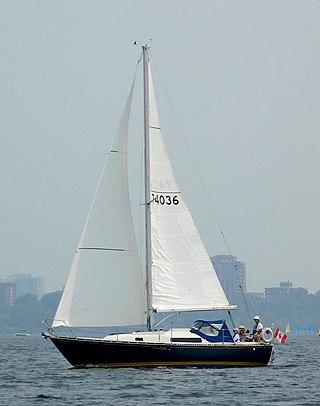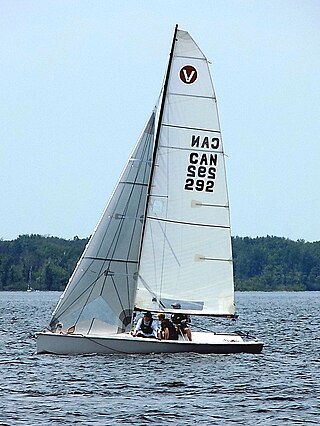
The Fireball is a British sailing dinghy that was designed by Peter Milne as a one-design racer and first built in 1962.

The International 14 is a British racing sailboat, crewed by two sailors. The class was established in 1928.
The Melges 17 is an American scow-hulled sailing dinghy that was designed by Reichel/Pugh as a one-design racer and first built in 2005.
The Melges 20, originally called the Audi Melges 20, is an American trailerable sailboat that was designed by Reichel/Pugh as a one-design racer and first built in 2007.
The Ecover Sailing team competed in the 2009 iShares Cup, showcasing world class racing around Europe. The races take place in Venice, Hyères, Cowes, Kiel, Amsterdam and Almeria, and the rebranded, 2010 Extreme Sailing Series.

The Farr 3.7 is a one-person sailing dinghy designed by Bruce Farr in 1971. The design plans are sold by the 3.7 Class Owners Association and they are built by a mix of professionals and home built by amateurs. The 3.7 Class is recognised by Yachting New Zealand as a national class and yachts are sailed in New Zealand, Australia and Great Britain. Full sets of plans have been sold worldwide to a number of individuals with greatest numbers in Germany, Japan, USA, South Korea, Poland, France, Belgium, Russia, Spain, Uruguay.

The ClubSwan 42, also called the Club Swan 42 and the New York Yacht Club 42 , is a Finnish sailboat that was designed by Germán Frers as a one design racer-cruiser and first built in 2005.
The ClubSwan 50 is a Finnish sailboat that was designed by Juan Kouyoumdjian as a one design and International Rating Certificate racer-cruiser, first built in 2015. The interior was designed by Michele Bönan.
The Swan 66 is a series of Finnish sailboats that were designed by Germán Frers as a cruiser-racers and first built in 2006. The boat was produced in the Swan 66 S (salon) and FD models. Both use the same hull design but different decks, and were introduced as part of celebrations of the builder's 40th anniversary.
The Swan 115 is a Finnish superyacht sailboat that was designed by Germán Frers as a racer-cruiser and first built in 2015. The design was built in both fixed keel and lifting keel versions as well as with two deck configurations, flush deck ("FD") and raised salon ("S").

The C&C 30 is a series of Canadian and American sailboats, that was first built in 1973.

The M32 is a class of sailing catamaran designed by Göran Marström and Kåre Ljung and first built in 2010 by Marstrom Composite AB. The design and production rights were sold in 2013 to Aston Harald Composite AB led by Håkan Svensson and run by Killian Bushe.

The Viper 640 is an American trailerable sailboat, that was designed by Brian Bennett for racing and first built in 1996.

The Beneteau Figaro 3, officially called the Figaro Beneteau 3, is a French hydrofoil-equipped sailboat that was designed by Van Peteghem/Lauriot-Prevost as a one design racer specifically for the Solitaire du Figaro race and first built in 2018. The boat and the race are named for the race's sponsor, the French newspaper Le Figaro.
The ETAP 24i is a Belgian trailerable sailboat that was designed by Marc-Oliver von Ahlen as a cruiser and first built in 1999.
The Melges 40 is an American sailboat that was designed by the Spanish design firm of Botin Partners as a one-design racer aimed at the European Grand Prix yacht racing circuit and first built in 2017.
The ClubSwan 36 is a Finnish sailboat that was designed by Juan Kouyoumdjian as a one design racer and first built in 2018. Giovanni Belgrano was the principal engineer and aerodynamic expert, while Hervé Devaux designed the rig.
The ClubSwan 80 is a Finnish maxi yacht that was designed by Juan Kouyoumdjian as a one design racer and first built in 2022.
The Beneteau 34.7, also sold as the First 34.7 and the First 10R, is a French sailboat that was designed by Bruce Farr as a cruiser-racer, optimized for International Rating Certificate racing and first built in 2005.
The Beneteau First 18 SE, previously called the Beneteau First 18 and the Seascape 18, is a French trailerable sailboat that was designed by Samuel Manuard as a planing one design racer-cruiser and first built in 2008. The industrial design work was done by Gigodesign.








